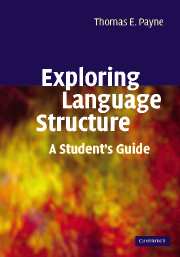Book contents
- Frontmatter
- Contents
- List of figures
- List of tables
- Preface
- Acknowledgments
- A note on transcriptions
- List of abbreviations
- 1 Introduction to morphology and syntax
- 2 Morphological processes and conceptual categories
- 3 Morphophonemics
- 4 Word classes
- 5 Exploring subclasses
- 6 Constituent structure
- 7 Language typology
- 8 Grammatical relations
- 9 Voice and valence
- 10 Multi-clause constructions
- Glossary
- References
- Subject and language Index
6 - Constituent structure
Published online by Cambridge University Press: 05 June 2012
- Frontmatter
- Contents
- List of figures
- List of tables
- Preface
- Acknowledgments
- A note on transcriptions
- List of abbreviations
- 1 Introduction to morphology and syntax
- 2 Morphological processes and conceptual categories
- 3 Morphophonemics
- 4 Word classes
- 5 Exploring subclasses
- 6 Constituent structure
- 7 Language typology
- 8 Grammatical relations
- 9 Voice and valence
- 10 Multi-clause constructions
- Glossary
- References
- Subject and language Index
Summary
As linguistic structures become larger and more complex, prose, position-class diagrams, and process rules begin to lose their effectiveness as means of representing and analyzing them. In particular, structures known as phrases and clauses typically have a great deal of internal complexity that is not amenable to the same kind of analysis as words are. Units within such larger structures may vary in their positions, and units in the same position may have a much wider range of functions than elements of word structure tend to have. For this reason linguists usually make a fairly major distinction between morphology (the study of the shapes of words) and syntax (the study of how words clump together in phrases and clauses).
Of course, this distinction is really a continuum. What is a syntactic pattern at one historical stage of a language may become morphological at a later stage (seldom the reverse). Since language change over time rarely proceeds in quantum leaps, there are many situations in which a syntactic pattern is “becoming” morphological. In such cases either a syntactic or a morphological analysis may be useful. Furthermore, as we have seen in earlier chapters, functions that are accomplished in the syntax of one language may be accomplished morphologically in another. So in reality the distinction between morphology and syntax is not always absolutely clear, though it is often very useful.
- Type
- Chapter
- Information
- Exploring Language StructureA Student's Guide, pp. 152 - 188Publisher: Cambridge University PressPrint publication year: 2006



